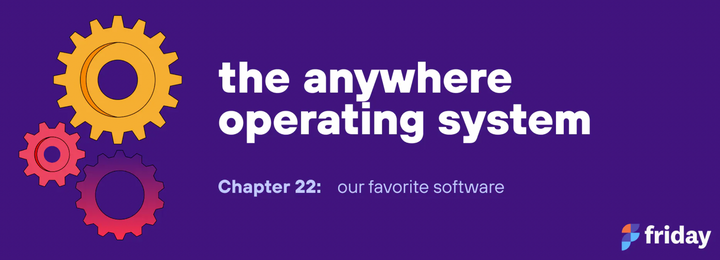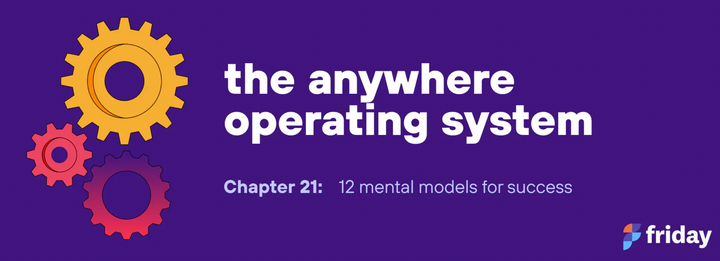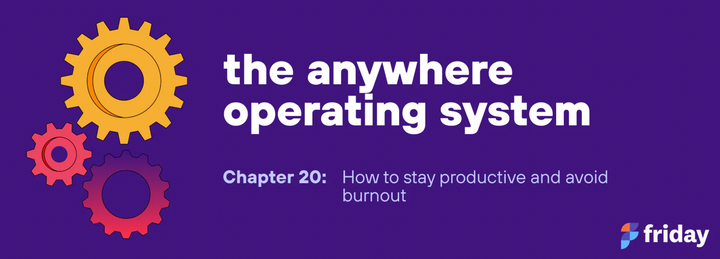Chapter 16: how to hire from anywhere

Let’s now talk about another key ingredient to growing your business from anywhere.
Hiring.
The promise of WFA means that you can hire amazing people, no matter where they live. The reality is that it can be tricky to identify and find talented people, especially if you are used to in-person interviews and trusting your gut.
In this chapter, I’m going to share everything I’ve learned about hiring people I’ve never met in person. As a frame of reference, we have teammates working across six different time zones at Friday spanning an 11-hour time difference. Most of the company has yet to meet each other in-person (yet).
How to get job applicants
If you want a decent number of applications for your job posting, there are a couple approaches you can take to open up the top of the funnel:
1. Post on a remote-first job board
WeWorkRemotely is the most well-known remote work job board I’ve found and is a great place to find quality applicants, especially for technical roles. You could also use hiring software like Workable to cross-post a listing across multiple job boards at once. Make sure the job posting is marked as remote-friendly though!
2. Post in multiple metros at once
Another hack I’ve seen (especially for fast-growing companies) is sharing the same job posting in several major cities at the same time. For example, you could post a remote-friendly software engineering role and mark the location as Boston. Then, you duplicate the same listing but change the location to New York or San Francisco.
There’s a pool of potential candidates who may not be searching for a remote-first role, but may be open to it. Make sure to get in front of these people too!
Screening candidates
Remote-first roles tend to get a much higher volume of applications compared to job postings with geographical constraints, so you will need to aggressively filter as fast as possible.
How do you do this?
Only you know the right answer for your business, but the #1 factor I screen for (besides skill) is the ability to convey ideas and information in writing. At Friday, we do most of our work asynchronously, so we need to hire people who can communicate in writing.
1. Ask open-ended questions early
When someone completes an application for a job opening at Friday, we have them answer questions like:
- What’s something you have built that you are super proud of and why?
- What’s something you believe to be true that most people you know would disagree with you about?
- What would you like to be when you grow up?
These questions may seem random and bizarre, but they are intentionally mapped to our company values:
- Question #1: We like hiring people who love to learn and build new things (Our value is “always learning”)
- Question #2: We aim to hire people with diverse perspectives, so we look for people who think outside the box and aren’t afraid to share it.
- Question #3: We ask people what they want to be when they grow up to understand a bit more about what motivates them. This is also tied to our company value of not taking ourselves too seriously.
These questions create an immediate filter, especially for spam applications. It’s hard to automate answers to these questions with a bot. You can also filter out individuals who aren’t paying attention.
2. Ask for tangible samples of work
The next thing you want to screen for is someone’s skills and ability. Have they created something that maps to what you are looking for in the role? If not, is there evidence that they can learn it?
For example, if you’re trying to hire a writer, ask for writing samples. If you’re trying to hire an engineer, ask for code samples or their GitHub profile. One of my favorite places to dig deeper is on the candidate’s personal website or portfolio, if it exists. Typically, if something is on someone’s personal website, it’s of greatest importance to them. This can be work-related, a hobby, or something else.
3. You don’t need to schedule a call right away!
Another trick I’ve learned is to use the open-ended responses to the questions as a conversation starter. I will send the candidate an email and say something like, “in your application you mentioned ____________, do you mind sharing a bit more about this?”
Once again, I do this to assess someone’s ability to write and convey ideas asynchronously. I rarely jump on a video or phone call right away. Sometimes I’ll exchange a few emails with the candidate before we get on a call. Emails are cheap for both parties. Zoom calls are not.
I think I’ve found a great candidate. What do I do now?
It’s not time to send an offer yet. There are still a couple more steps:
1. Schedule a video call
At this point, you should have 3-5 quality candidates. I’d encourage you to schedule time to chat over a video call. I typically ask more questions, share more about the role, expected responsibilities, and continue the conversation we started over email.
I recommend a video call so you can learn as much as possible about the person you’re trying to hire. The bedrock for the conversation has been established through the email and work samples, so you’re just looking for major red flags.
Depending on how the call goes, I’d strongly recommend the final and most important step in the interview process.
2. Work on a test project
For the final candidate(s), I recommend working on a paid test project that is limited in scope. Ideally, the project should take 3-6 hours. The basic criteria is below:
- It should be paid — This sends a signal that you value the candidate’s time. I ask for their hourly contracting rate as a reference point
- It should be limited in scope — This test project can’t be too time consuming, especially for candidates who are employed elsewhere
- You should have a flexible timeline — The candidate should be able to work on the project anytime they want, like weekends. Once again, we are testing someone’s ability to work asynchronously
Think about it - if you are trying to figure out what it’s like to work with someone full-time, what if you actually worked with them for a little bit? This is not rocket science.
A test project is a great way to reduce risk for both you and the candidate. The candidate can confirm that you are a nice person and you can figure out if the candidate is a good fit. I can’t tell you how many times test projects have saved me from making a mistake hire.
I’ve found the person I want to hire!
Excellent! Now it’s time to extend an offer. I recommend creating a job scorecard that outlines the role, responsibilities, and expected output.
1. Check references
It’s easy to skip over references as it can introduce a coordination challenge, especially if you are hiring someone in another timezone. As a base case, I recommend sending questions over email and having the reference reply on their own schedule. It can’t hurt to jump on a Zoom call too. The most important thing is to do the work and ping the references.
2. Logistical considerations
We use a professional employment organization (PEO) to handle paperwork and hiring across state boundaries (US-based). These vendors help you handle the complexities of dealing with each individual state and its local laws. While it’s still annoying to deal with, a PEO does more of the work for you.
Likewise, if you hire internationally, you should explore a similar service so you can focus on growing your business instead of doing paperwork. There’s a growing list of providers like Deel, Remote, Papaya Global, and other services worth looking into.
Aisha’s perspective
“Getting hired at Friday was truly a special experience I won’t forget. COVID-19 was still taking its toll on the world, so I knew there was a low chance of getting an in-person position. That meant that I could apply to places from all over, because the distance would not be an issue.
I stumbled across Friday’s content marketing position and it intrigued me. I enjoy writing, but I never wrote on business and marketing. I decided to take a chance and emailed Luke my résumé and a few writing samples. The first ones I sent were all excerpts of my novels I’m writing. That wasn’t a clear indication of if I could write for Friday. Then, I decided to send in some academic research papers in the hopes that my voice would be a bit more clear.
A week had passed and Luke mentioned that while it was clear that I could write, it wasn’t enough to convince him that I could write about business topics. He decided to help me out and say what type of writing he was seeking, and proposed I write a short blog post about goal-setting if I wanted.
I vividly remember sitting at my dorm room’s desk determined to write a blog post, something I had never written before. Four hours later, I had my first ever blog post written. I sent it to him not knowing what to expect, but it ended with a Zoom interview.
Because I already emailed Luke back and forth for a few days, the interview was short and more of a relaxed chat to get to know me and my goals. By the end of it, he gave me an offer.
It was a great learning experience for me, pushing me to places I never thought I’d have to go. I worked for this position, and it was great to see that it all paid off in the end.”
In conclusion
Hiring people you have never met in person may seem scary, but if you create a process and stick by it, you can dramatically reduce the potential downside, which is all you can ask for when hiring. In the next chapter, we’ll discuss how to onboard new hires, as sending the offer is only the beginning of the journey!
Want to keep reading? In the next chapter we talk about how to onboard new hires.


